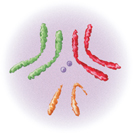11.4 Meiosis
 How many sets of genes are found in most adult organisms?
How many sets of genes are found in most adult organisms? What events occur during each phase of meiosis?
What events occur during each phase of meiosis? How is meiosis different from mitosis?
How is meiosis different from mitosis? How can two alleles from different genes be inherited together?
How can two alleles from different genes be inherited together?
homologous • diploid • haploid • meiosis • tetrad • crossing-over • zygote
Compare/Contrast Table Before you read, make a compare/contrast table to show the differences between mitosis and meiosis. As you read, complete the table.
THINK ABOUT IT As geneticists in the early 1900s applied Mendel's principles, they wondered where genes might be located. They expected genes to be carried on structures inside the cell, but which structures? What cellular processes could account for segregation and independent assortment, as Mendel had described?
Chromosome Number
 How many sets of genes are found in most adult organisms?
How many sets of genes are found in most adult organisms?
To hold true, Mendel's principles require at least two events to occur. First, an organism with two parents must inherit a single copy of every gene from each parent. Second, when that organism produces gametes, those two sets of genes must be separated so that each gamete contains just one set of genes. As it turns out, chromosomes—those strands of DNA and protein inside the cell nucleus—are the carriers of genes. The genes are located in specific positions on chromosomes.
Diploid Cells Consider the fruit fly that Morgan used, Drosophila. A body cell in an adult fruit fly has eight chromosomes, as shown in Figure 11–14. Four of the chromosomes come from its male parent, and four come from its female parent. These two sets of chromosomes are homologous (hoh MAHL uh gus), meaning that each of the four chromosomes from the male parent has a corresponding chromosome from the female parent. A cell that contains both sets of homologous chromosomes is said to be diploid, meaning “two sets.”  The diploid cells of most adult organisms contain two complete sets of inherited chromosomes and two complete sets of genes. The diploid number of chromosomes is sometimes represented by the symbol 2N. Thus, for Drosophila, the diploid number is 8, which can be written as 2N = 8, where N represents the single set of chromosomes found in a sperm or egg cell.
The diploid cells of most adult organisms contain two complete sets of inherited chromosomes and two complete sets of genes. The diploid number of chromosomes is sometimes represented by the symbol 2N. Thus, for Drosophila, the diploid number is 8, which can be written as 2N = 8, where N represents the single set of chromosomes found in a sperm or egg cell.
Haploid Cells Some cells contain only a single set of chromosomes, and therefore a single set of genes. Such cells are haploid, meaning “one set.” The gametes of sexually reproducing organisms, including fruit flies and peas, are haploid. For Drosophila gametes, the haploid number is 4, which can be written as N = 4.

FIGURE 11–14 Fruit Fly Chromosomes These chromosomes are from a fruit fly. Each of the fruit fly's body cells is diploid, containing eight chromosomes.

Table of Contents
- Formulas and Equations
- Applying Formulas and Equations
- Mean, Median, and Mode
- Estimation
- Using Measurements in Calculations
- Effects of Measurement Errors
- Accuracy
- Precision
- Comparing Accuracy and Precision
- Significant Figures
- Calculating With Significant Figures
- Scientific Notation
- Calculating With Scientific Notation
- Dimensional Analysis
- Applying Dimensional Analysis




